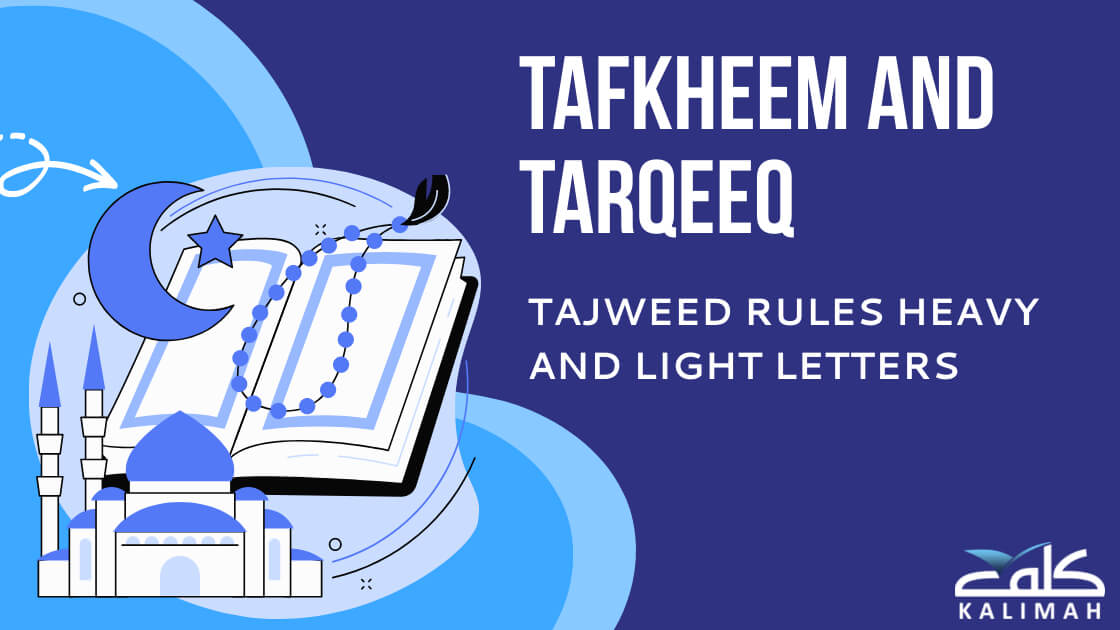Tafkheem And Tarqeeq: The Arabic alphabet’s letters are divided into three categories based on whether they are heavy “Tafkheem letters” or light “Tarqeeq letters”: letters that are always Heavy, letters that are always Light, and letters that are sometimes heavy and sometimes light.
What Is Tafkheem in Tajweed?
Linguistically, Tafkheem (Letters that are Heavy) is heaviness and thickening. Idiomatically, it is a state of strength and heaviness attached to the letter when pronouncing it, so the mouth is filled with its echo, and Tafkheem and thickening are synonymous words with one meaning.
What Is Tarqeeq in Tajweed?
Linguistically, Tarqeeq (Letters that are Light) means thinning. Idiomatically, it is a state of thinness and lightness attached to the letter when pronouncing it, so the mouth is not filled with its echo.
The Seven Heavy Letters (Tafkheem of letters)
There are seven letters that are always heavy in the Arabic alphabet. They are organized using the Arabic abbreviation (خص ضغط قظ). Regardless of their conditions, they are always heavy (carrying a fatha, dammah, sukun, or kasrah). These letters are heavy in all cases. Nothing is excluded from it, whether it is adjacent to a light letter or not.
The letters with the strongest level of Tafkheem are Ta’(ط), Dhaad(ض), Sad(ص), Dha’(ظ), Qaf(ق), Gheen(غ), then Kha’ ,(خ) respectively. Examples are as follows:
| Letter | Example From the Quran | Note |
| Taa (ط) | “وَأَن لَّوِ اسْتَقَامُوا عَلَى الطَّرِيقَةِ لَأَسْقَيْنَاهُم مَّاءً غَدَقًا” | The Letter Taa in the word الطَّرِيقَةِ is the example here. |
| Daad (ض) | “وَأَقْرِضُوا اللَّهَ قَرْضًا حَسَنًا” | The letter Daad in the words أَقْرِضُوا – قَرْضًا is the example here. |
| Saad (ص) | “وَيُقِيمُونَ الصَّلاةَ” | The letter Saad in the word الصَّلاةَ is the example here. |
| Dhaa (ظ) | “وَإِنَّ لِلَّذِينَ ظَلَمُوا عَذَابًا دُونَ ذَلِكَ” | The letter Dhaa in the word ظَلَمُوا is the example here. |
| Qaaf (ق) | “إنَّ اللَّه عَلَى كُلِّ شَيْءٍ قَدِيرٌ” | The letter Qaf in the word قَدِيرٌ is the example here. |
| Ghayn (غ) | صِرَاطَ الَّذِينَ أَنْعَمْتَ عَلَيْهِمْ غَيْرِ الْمَغْضُوبِ عَلَيْهِمْ | The letter Ghayn in the words غَيْرِ – الْمَغْضُوبِ is the example here. |
| Khaa (خ): | خَالِدِينَ فِيهَا أُوْلَئِكَ هُمْ شَرُّ الْبَرِيَّةِ | The letter Khaa in the word خَالِدِينَ is the example here. |
Tarqeeq “light” Letters:
All the rest of the Arabic letters are always light (follow the Tarqeeq Rules) and it is not permissible to make anything of them heavy with the exception of these three (ا – ل – ر). Examples are as follows:
| Letter | Example From the Quran | Note |
| Taa (ت): | إِنَّهُ كَانَ تَوَّابًا | The letter Taa ت in the word تَوَّابًا is the example here. |
| Seen (س): | رَبِّ السَّمَاوَاتِ وَالأَرْضِ وَمَا بَيْنَهُمَا الرَّحْمَنِ | The letter Seen س in in the word السَّمَاوَاتِ is the example here. |
| Meem (م): | الرَّحْمَٰنُ عَلَّمَ الْقُرْآنَ | The letter meem م in the words الرَّحْمَٰنُ – عَلَّمَ is the example here. |
Tafkheem And Tarqeeq of letter Alif (ا)
| Tafkheem rules | Tarqeeq Rules |
| The Letter alif (ا) follows the condition of what comes before it. If the letter preceding Alif (ا) is heavy, then the alif (ا) will be heavy, Examples are as follows:قال (This alif (ا) will be heavy because qaf (ق) is a heavy letter). مرضا (This alif (ا) will be heavy because Dhaad(ض)is a heavy letter) |
If the letter preceding alif (ا) is light, then the alif (ا)will be light. Examples are as followsكان :(this alif (ا) will be light because kaf (ك) is a light letter)بَٰخِعٞ “(this alif (ا) will be light because ba’ (ب) is a light letter) |
Tafkheem And Tarqeeq of letter laam (ل)
| Tafkheem Rules | Tarqeeq Rules |
| The Letter laam (ل) is always light except when in the name of Allah الله, it is preceded by a dammah or a fatha. or when you are starting recitation with it, in these cases it is heavy or mufakham, example is as follows:”عبدُ الله” | The ruling of the laam (ل) mentioned in the Holy Qur’an revolves between Tafkheem and Tarqeeq but the origin of laam (ل) is Tarqeeq. It is light also in the name of Allah الله if it comes after an original kasrah h or an accidental kasrah h, examples are as follows: “بِسۡمِ ٱللَّهِ””قُلِ ٱللَّهُمَّ” |
Tafkheem and Tarqeeq of Raa (ر)
The letter ra’ (ر) has many rules to be either heavy) mufakham (or light(muraquq) but can be summarized into the following:
(Read the full discussion of The rules of Raa in this article)
1. There are five types for when the ra’ (ر) produces a heavy sound (Tafkheem of ra’ (ر):
- When the ra’ (ر)carries a fatha or dammah, examples are as follows:
- رَسُولُ اللهِ: the ra’ (ر) carries a fatha.
- “فَعَقَرُوهَا: the ra’ (ر) carries a dammah.
- When the ra’ (ر)carries a sukun and the letter before it carries a fatha or dammah, examples are as follows:
- “وَالأرْضِ وَمَا طَحَاهَا”
- “حَتَّىٰ زُرْتُمُ الْمَقَابِرَ”
- When the ra’ (ر) carries a sukun, the letter before it carries a kasrah, and the letter after the ra’ (ر)is heavy and doesn’t carry a kasrah h, example is as follows:
- ” إِنَّ جَهَنَّمَ كَانَتْ مِرْصَادًا”
- When the ra’ (ر) carries a sukun and the letter before it carries a ‘helping’ kasrah (not a real kasrah), example is as follows:
- “ارْجِعِي إِلَى رَبِّكِ”
- When the ra’ (ر) carries a sukun as a result of wanting to stop (therefore not a real sukun), and the letter before it is not a ya’ (ي) and carries a sukun, and the letter before that has either a fatha or dammah, examples are as follows:
- “وَالْعَصْرِ”: the letter before that has a fatha.
- “خُسْرٍ”: the letter before that has a dammah.
2. There are four types for when the ra’ (ر) produces a light sound (Tarqeeq of ra’ (ر):
- When the ra’ (ر)carries a kasrah h, examples are as follows:
- وَبُرِّزَتِ الْجَحِيمُ لِلْغَاوِينَ
- لِكُلِّ امْرِئٍ مِّنْهُمْ يَوْمَئِذٍ شَأْنٌ يُغْنِيهِ
- When the ra’ (ر) carries a sukun and the letter before it carries an original kasrah in the same word and a heavy letter doesn’t follow it, example is as follows:
- اذهبا إلى فرعون إنه طغى
- When the ra’ (ر) carries a sukun (as a result of stopping, either in the middle or end of an ayah) and the letter before it is a ya (ي) (elongated or otherwise) and the carries a ya (ي) sukun, examples are as follows:
- ذَٰلِكَ الْفَوْزُ الْكَبِير
- يَوْمَئِذٍ لَّخَبِيرٌ
- When the ra’ (ر) carries a sukun (due to stopping either in the middle or end of an ayah), and the letter before it is a light letter which carries a sukun, and the letter before this carries a kasrah h, example is as follows:
- هَلْ فِي ذَلِكَ قَسَمٌ لِذِي حِجْرٍ
Tajweed is one of the sciences that every Muslim must learn and take care of, due to its attachment to a worship that is required of every single individual, which is reading the Holy Qur’an.
So: “Oh God, make the Great Qur’an the healing of our chests and the removal of our worries and sorrows, and remind us of it that we have forgotten, and teach us of it what we are ignorant of, and grant us its recitation during the hours of the night and the ends of the day”.
🌟 Unlock Your Potential in Arabic and Quran with Kalimah Center! 🌟
Ready to deepen your connection with the Quran and enhance your understanding of Arabic? Join Kalimah Center today and embark on a transformative journey of learning and growth! Our professional, handpicked Online Arabic and Quran Tutors are dedicated to helping you master these essential skills with ease and expertise.
📚 Explore Our Courses:
Online Arabic Course: Tailored to your level, our comprehensive Arabic program includes 16 teaching levels and 400+ hours of personalized sessions.
Online Quran With Tajweed Course: Perfect for non-Arabic speakers, our course spans 13 levels and equips you with Tajweed mastery from beginner to advanced.
Online Arabic Course For Kids: Nurture your child’s love for Arabic with our engaging and structured program, available in 24 levels for primary, intermediate, and secondary stages.
💡 Why Choose Kalimah?
Expert Tutors: Learn from native Arabic speakers and Ijazah-certified teachers who prioritize your progress.
Flexible Learning: Enjoy one-on-one classes, 24/7 access to materials, and interactive exercises for a dynamic learning experience.
Comfortable Environment: Benefit from a supportive and encouraging atmosphere, where mistakes are seen as opportunities for growth.
Proven Success: With over 8,000 students worldwide and glowing testimonials, Kalimah Center is your trusted partner in Arabic and Quran education.
🚀 Start Your Free Trial Today! 🚀
Don’t miss out on this life-changing opportunity to deepen your faith and knowledge. Sign up now for your free trial and take the first step towards becoming a better practicing Muslim with Kalimah Center!
Conclusion:
Tafkheem and Tarqeeq categorize Arabic letters based on their heaviness or lightness. Tafkheem, representing heaviness, applies to seven letters consistently, such as Ta’, Dhaad, and Qaf. Tarqeeq, signifying lightness, applies to all other letters except three (ا – ل – ر).
Alif’s heaviness depends on the preceding letter, while laam is usually light except in specific cases. Raa’s pronunciation can be heavy or light based on various rules. Understanding these distinctions is crucial for accurate Quranic recitation.














